Intel Dual Core Performance Preview Part II: A Deeper Look
by Anand Lal Shimpi on April 6, 2005 12:23 PM EST- Posted in
- CPUs
Business Application Performance
Business Winstone 2004
Business Winstone 2004 tests the following applications in various usage scenarios:
- Microsoft Access 2002
- Microsoft Excel 2002
- Microsoft FrontPage 2002
- Microsoft Outlook 2002
- Microsoft PowerPoint 2002
- Microsoft Project 2002
- Microsoft Word 2002
- Norton AntiVirus Professional Edition 2003
- WinZip 8.1
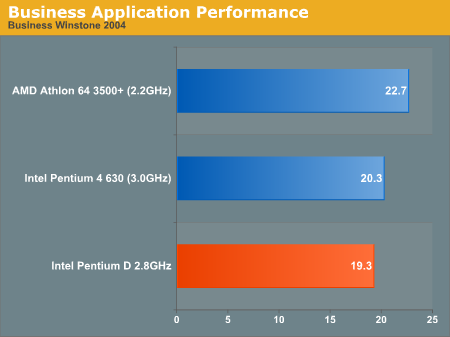
The Pentium 4 and Pentium D perform quite similarly here, but the Athlon 64 3500+ is obviously the strongest performer out of the three when it comes to single threaded business applications.
Office Productivity SYSMark 2004
SYSMark's Office Productivity suite consists of three tests, the first of which is the Communication test. The Communication test consists of the following:
"The user receives an email in Outlook 2002 that contains a collection of documents in a zip file. The user reviews his email and updates his calendar while VirusScan 7.0 scans the system. The corporate web site is viewed in Internet Explorer 6.0. Finally, Internet Explorer is used to look at samples of the web pages and documents created during the scenario."

The next test is Document Creation performance:
"The user edits the document using Word 2002. He transcribes an audio file into a document using Dragon NaturallySpeaking 6. Once the document has all the necessary pieces in place, the user changes it into a portable format for easy and secure distribution using Acrobat 5.0.5. The user creates a marketing presentation in PowerPoint 2002 and adds elements to a slide show template."
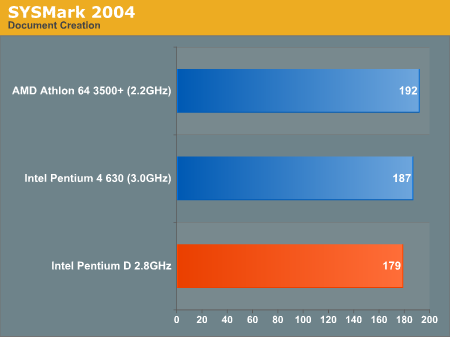
The final test in our Office Productivity suite is Data Analysis, which BAPCo describes as:
"The user opens a database using Access 2002 and runs some queries. A collection of documents are archived using WinZip 8.1. The queries' results are imported into a spreadsheet using Excel 2002 and are used to generate graphical charts."
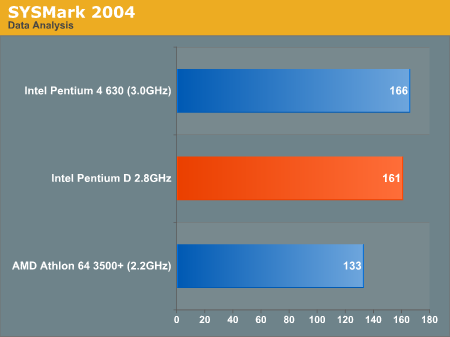
SYSMark paints a much more evenly matched picture between AMD and Intel in the Office Productivity suite. What's interesting is that even AMD recommends SYSMark 2004 as the best overall system performance test for multi-core desktop CPUs.
Business Winstone 2004 includes a multitasking test as a part of its suite, which does the following:
"This test uses the same applications as the Business Winstone test, but runs some of them in the background. The test has three segments: in the first, files copy in the background while the script runs Microsoft Outlook and Internet Explorer in the foreground. The script waits for both foreground and background tasks to complete before starting the second segment. In that segment, Excel and Word operations run in the foreground while WinZip archives in the background. The script waits for both foreground and background tasks to complete before starting the third segment. In that segment, Norton AntiVirus runs a virus check in the background while Microsoft Excel, Microsoft Project, Microsoft Access, Microsoft PowerPoint, Microsoft FrontPage, and WinZip operations run in the foreground."
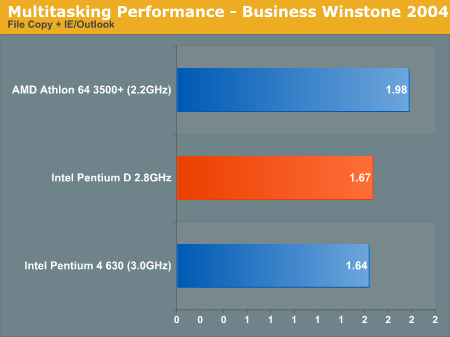
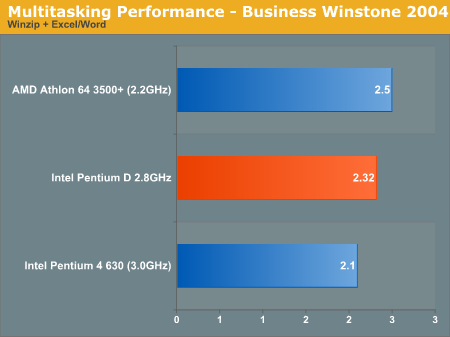
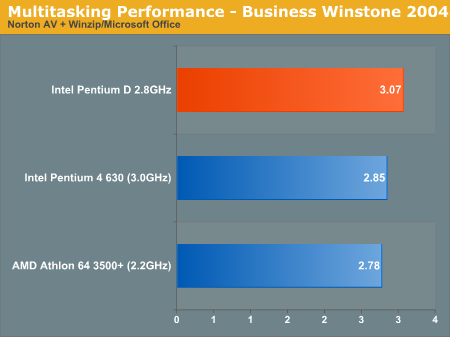
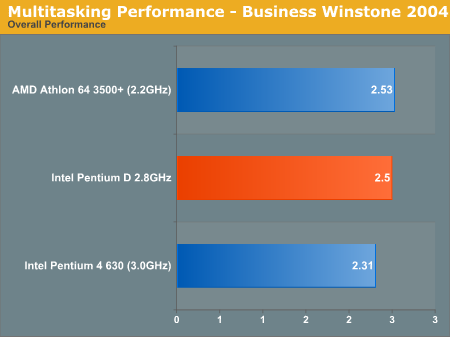
The multitasking tests show the Pentium D 2.8GHz and the Athlon 64 3500+ as equal competitors, with AMD winning the first two tests and Intel winning the last. This just goes to show you that not all multitasking will be immediately faster on a dual core chip.










106 Comments
View All Comments
segagenesis - Wednesday, April 6, 2005 - link
Since I mostly play games ill stick to buying the AMD64 3500+. Thanks. My definition of multi-tasking is using a whole other computer ;)The Pentium D seems pretty decent at multitasking as you would define running two things at once but I rarely do that sort of thing since its kind of dumb to encode a DVD in the background while playing a game. Or does encoding a DVD really interfere with browsing the web? I dont know... that and the heat factory output as if it was bad enough is now worse.
Woodchuck2000 - Wednesday, April 6, 2005 - link
#23 - I'm assuming that a dual core A64 at 2.2GHz will blow a Pentium D out of the water at any of the launch frequencies! The Prescott core isn't really designed for multi-core operation, and needs some kind of arbitration logic and some funky-memory-controlling-thingy to work. As a result, the performance improvements in multi-threaded applications aren't anything like the theoretical extra 100% another core could bring. With A64 being designed for multi-core operation I'd expect the increase in performance to be nearer 85%.As regards the performance gap between the P4 630 and A64 3500+, the majority of the benchmarks shown here are designed specifically to show performance improvements in multi-core processors. The 630 is hyper-threaded and therefore logically multi-cored, if not physically so. As such the 630 will have artificially high performance compared with the 3500+ - in most single-application benchmarks, the AMD chip would thrash both Intel chips.
Is there any chance of adding benches for the 630 with HT disabled (or at least giving us an idea of performance.)? We've got a vanilla A64 versus a HT 630 and Dual-core system. It'd be good to see how a single core performs for reference.
Anand Lal Shimpi - Wednesday, April 6, 2005 - link
Jeff7181I really can't say more, but you are barking up the wrong tree with those assumptions :)
AMD's dual core will be quite impressive, even more so than Intel's. Don't look at performance as the only vector to measure though...
marcusgarcia
We did look at HT performance when it came out, but the problem is that HT doesn't improve performance in all cases. Look at the Gaming Multitasking Scenario 2 tests, HT reduced performance significantly - most likely because DVD Shrink and Doom 3/Splinter Cell were both contending for floating point resources that were in use. Dual core solves this problem by having two complete sets of execution units, so there's no worry about contention between threads for shared resources.
As far as Half Life 2 goes, it is still single threaded so its performance characteristics would be no different than what you see here.
mlittl3
I've been looking into running VoIP or some sort of voice chat program in the background, the problem surfaces in trying to put together a reliable, repeatable workload. Dual core will most definitely help there, but how much - I do not know.
I haven't given up yet :)
BruceDickenson
Glad to have you on-board and thanks for the kind words :)
Woodchuck2000
The new dual core chips are still LGA-775, but they do require a new motherboard (unlike AMD's solution which just requires a new BIOS). Currently Intel's 945 and 955 chipsets will support dual core, and tomorrow I should have a nForce4 SLI Intel Edition board that will support dual core as well. The new NVIDIA chipset does support dual core, but it's up to motherboard makers to implement support for it in their designs.
Check with the motherboard maker to make sure that dual core is explicitly supported by the board, it should say so somewhere in the manual or on the box.
Take care,
Anand
Jeff7181 - Wednesday, April 6, 2005 - link
#22... Anand said a 2.2 GHz Athlon 64 won't compete with the 2.8 GHz Pentium D. That either means a 2.2 GHz dual core Athlon 64 will have lackluster performance, or it will be AMD's new enthusiast line like the FX is right now, which means it would be competing with the Extreme Edition chips, not the regular line.I guess there's a 3rd possibility. He was referring to dual core Opterons which obviously won't compete with the Pentium D any more than the Opteron competes with the Pentium 4 right now.
Woodchuck2000 - Wednesday, April 6, 2005 - link
Just out of interest, does anyone know what socket do the new cores use? Will the new nVidia chipset support the new cores (it was hinted at briefly, but not stated explicitly...)?#19 - What's your source for those assertions? I've heard reports that AMD have got samples running at well over 2GHz and since the K8 architecture is natrually better suited to multiple cores I'd have expected blistering performance. BTW, does anyone know if the AMD cores will be based on the new Venice rev? Is SSE3 a given?
BruceDickenson - Wednesday, April 6, 2005 - link
Hey all, long time reader, this is my first "post"/comment...Just had to say this is one of the most interesting articles I've read in a long time. I loved the NCQ tangent, it almost felt like you were part of a conversation when you read how Lal Shimpi analyzed the anomaly in his testing.
Loved it! Thanks AT!
marcusgarcia - Wednesday, April 6, 2005 - link
14# again.Forgot to say in the last post, my rant is about HT, not dual cores.
I know 2-cores won't make THAT difference on these trivial things (who needs another 2.8ghz for simple stuff?)...but..HT is benefiting GREATLY from it, yet noone mentioned it and didn't even try this sort of test when HT was launched.
When you see the 3.0 HT doing better than a AMD 3500+ (supposedly 500 points faster), you gotta ask how badly would it beat the AMD 64 3000+, which happens to cost almost the same than the P4 3.0 ghz...which happened to destroy the much faster AMD on the test.
That pretty much sucks and leave us with the impression that people either:
a - wanted to benefit AMD
or
b - were too ingenuous to think on these tests when doing HT tests (which can't be true because i always wanted them)
Jeff7181 - Wednesday, April 6, 2005 - link
Errr... correction...1.) The dual core 2.2 GHz Athlon-64's will be less than impressive and won't even perform in the same class as a Pentium D @ 2.8 GHz.
2.) The mainstream Athlon-64 dual core chips will be running at much less than 2.2 GHz, and the 2.2 GHz dual cores will be the FX line, which compete with the Extreme Edition Pentiums.
marcusgarcia - Wednesday, April 6, 2005 - link
14#Completely wrong.
1º: Outlook checks 8 pop accounts for mail and apply it's rules to it every minute or so.
2º: MSN with webcam can eat quite some CPU, specially because i play on the dark with the "low light filter" turned on, which happens to eat quite some CPU.
3º: For every file opened/closed both the AVG and the MS anti-spyware are going to have a check if that's malicious and if the action is allowed.
When i close everything and run 3dmark01 i get around 300 - 600 more points out of it from my 12200 points score.
PS: don't forget IE, which is usually opened here or on tom's hardware (or both and some more), which happen to have a lot of those huge flash banners.
I think that DOES make *a lot* of difference.
Add to that the fact of many people using skype while gaming, mainly on FPS and RTS, which can make all the difference.
Jeff7181 - Wednesday, April 6, 2005 - link
"Let's just say that the dual core Athlon 64 running at 2.2GHz won't be compared to a dual core Pentium D running at 2.8GHz."So you leave two possibilities.
1.) The dual core 2.2 GHz Athlon-64's will be less than impressive and won't even perform in the same class as a Pentium D @ 2.8 GHz, but rather dual core Extreme Edition chips.
2.) The desktop dual core Athlon-64's will be running at much less than 2.2 GHz.